The 31st/42nd Battalion Newsletter Vol1.2 was issued just prior to the Christmas 2019 break.
Cliick on the Link Below for the latest edition.
191213 3142 RQR Newsletter Vol 1_2 HI RES
The 31st/42nd Battalion Newsletter Vol1.2 was issued just prior to the Christmas 2019 break.
Cliick on the Link Below for the latest edition.
191213 3142 RQR Newsletter Vol 1_2 HI RES
WHEN guest of honour Brigadier Stephen Graw RFD, delivered the Reflections Address to the annual Kennedy Regiment Commemorative Service in St James Cathedral, Townsville, on Sunday, 20 August, 2017, he reminded many — if not all — of the idiosyncrasies of service that continue to transcend our lives long after we have ‘marched out’.
As a former Commanding Officer of the 31st Infantry Battalion, the Royal Queensland Regiment, and former Commander of the 11th Brigade, Brigadier Graw paid tribute to many names that have contributed to the 31st Battalion’s long-standing reputation. There were also the anecdotes that remain strong memories of service and mateship.
This was the second year that the 31st and 42nd Infantry Battalions have joined together in the long-standing commemorative service, which began many years ago in the Garrison Church in Sydney’s Rocks precinct.
Following is the Brigadier’s address:
WHEN JOHN GARDNER asked me to speak today on the topic Reflections, I thought — probably for the first time — about what the real ‘take home’ lessons from my time in uniform were — and I decided, on reflection, that there were three ‘stand-outs’.
The first was the opportunities that the Army gave me to do all sorts of things that I would not otherwise have done; to meet and work with all sorts of people I would not otherwise have met or worked with; and the chance to develop new skills and capabilities that I might otherwise never have acquired.
In 1972, the Army took a pretty shy young 18-year-old and through its training — and by imposing its standards and expectations — it gave me the self-confidence and self-belief to attempt things I would probably never otherwise have attempted. And when those attempts succeeded, it reinforced that self-confidence and self-belief by recognising and rewarding the successes and opening other doors.
The Army also gave me the opportunity to develop organisational and leadership skills that were readily transferrable to just about everything else I have done in life. It taught me how to teach and pass on skills to others. The Military Instruction Techniques that I learned and practiced as a young NCO have successfully underpinned how I have taught, in both military and civilian contexts, for the last 40 years.
It taught me to plan and to execute and to persevere even when things didn’t go as I wanted them to go. It taught me self-discipline. It taught me the importance of teamwork and of loyalty — and, most importantly, that loyalty works both ways, up and down. It taught me the need to ensure that when you ask people to do things, you also give them what they need to do them. It taught me that you need to communicate to people, simply and clearly, exactly what you want them to do and then check their understanding (‘Fire and forget’ has no role in managing people). And, finally it taught me the importance of knowing your soldiers and of recognising effort and achievement.
The second ‘stand out’ is that almost indefinable attitude that you find with soldiers — everything is achievable. Soldiers might complain when they are asked to do things with which they disagree, they might point-out flaws in the plan, might suggest better ways of doing it but, when the decision is made, they just get on and do it.
There is also often a touch of the larrikin in what they do and how they do it — usually involving a dry and often self-deprecating wit — which they can use to deadly effect with those they regard as ‘up themselves’. You find it in the nicknames that proliferate across the military — blue orchids for the RAAF, blanket counters or cockroaches for the ‘Q’ies, bait-layers for the cooks, dropshorts for the Arty — and you all know all the rest.
Individuals also get rechristened with names that their mothers would never have given them: not just the ‘Bluies’ or the ‘Chalkys’ that you find in every walk of life, but ‘Pop’ or ‘Dad’ for anyone who is a bit older than the rest of the group, ‘kit-kat’ for the LCPL who was always ‘just taking a break‘, Aspro’ — the slow-working dopes and, of course, in a more local context, ‘Burnie’ for the young officer who, having been tasked with checking fuel levels in the trucks in the vehicle park, did so using a kerosene lantern for illumination — with the obvious results.
And describing someone simply as a ‘Space Cadet’ is more clearly descriptive of their failings than any hundred-word paragraph could ever be.
You also find humour in soldiers’ everyday conversations and actions. Some that spring readily to mind are Warrant Officer Don McClure’s suggestion to Cpl Rose, a particularly short young female soldier, delivered at full roar across the parade ground, that she should ‘sue the Council’, which was followed, when she asked “why sir?”, with the explanation that it was “because they built the road too close to your behind” (or words to that effect). Or Capt John Butler who, when asked by 2LTs Stu Gauld and Paul Minton (both then lobbying hard to get their second pips), what the collective noun for second lieutenant’s was, replied, without looking up from the papers on which he was working, “a thicket, now get out.” Or the then Sgt Ken Hall who, having asked his brand new 2Lt Platoon Commander whether he had taken his anti-malarial pill that day and been told that he had not been issued any, re-assured him that he had a few spares — and then fed him a blue tablet from the old water sterilisation kits every day for the rest of the exercise. Or the probably apocryphal comment supposedly written on an anonymous officer’s PR19 — “Soldiers will follow this officer anywhere, if only out of idle curiosity.” The Army might not be the only place you find characters like that, but it certainly seems to be home to more than its fair share.
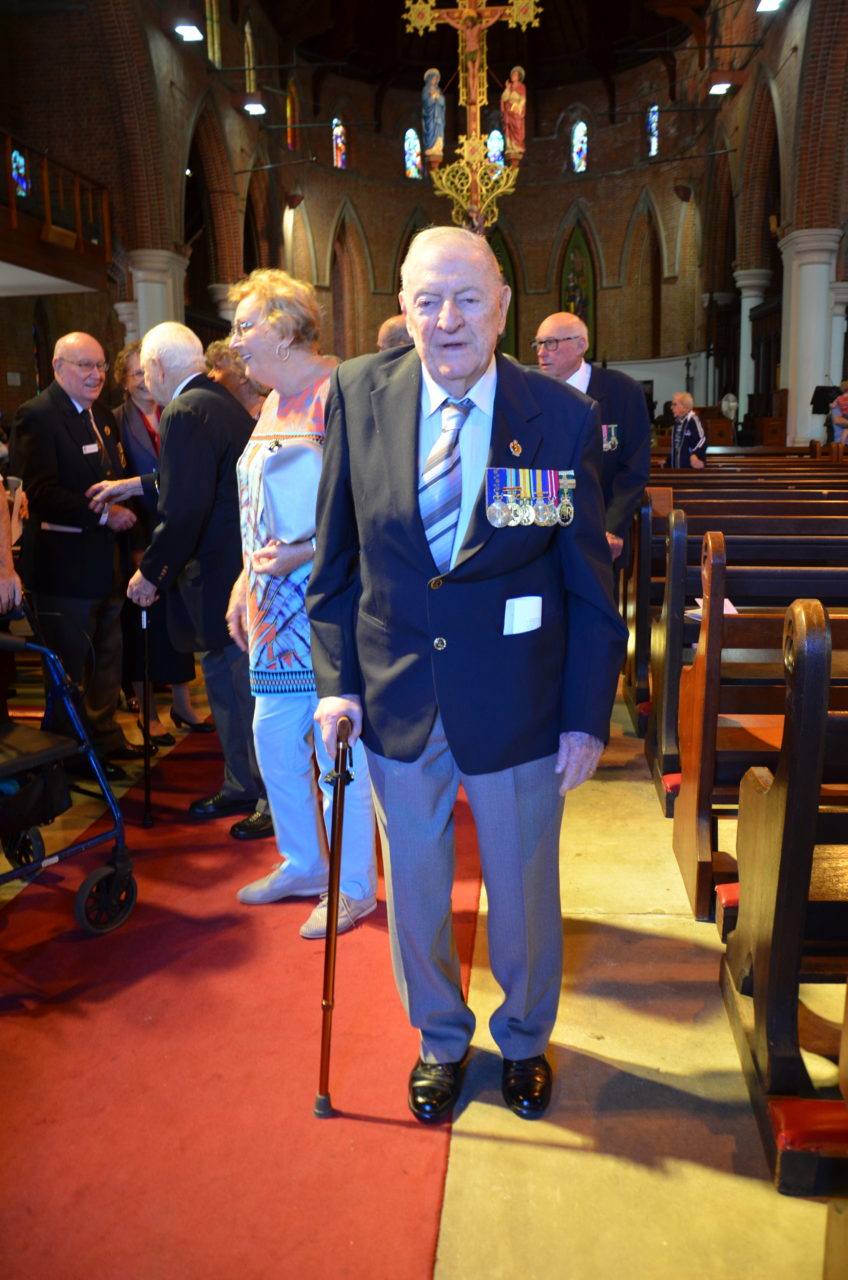
Colonel Hugh Gaffney, the grand old man of the Army Reserve in North Queensland.
The third and, probably, most important ‘stand-out’ from my time in the Army (and by now it is probably obvious) is the people.
Every single one of those with whom I worked, in any rank and whether Regular or Reserve, influenced me in one way or another. Our patron, Colonel Hugh Gaffney, the grand old man of the Reserve in North Queensland, entrusted me, as a young Lieutenant, with the running of a recruit course in 1980 — with 146 soldiers and three second lieutenants and a female corporal as my four platoon commanders. In a way it was like being thrown in at the deep end (though the SO2, MAJ Bob Semple, did keep a fatherly eye on things to make sure that I did not stuff up too badly). However, the lessons I learnt from that stood me in good stead for the rest of my military career. Hugh also taught me a number of other invaluable lessons using the time-honoured method of delivering a firm kick up the backside when I did stuff up. Those kicks were all, I should confirm, thoroughly deserved.
Neil Gist was my boss at OCTU for two years. He reinforced a lot of what I had learned up to that point about practical leadership and also about the importance of timely and detailed planning – the seven ‘P’s. He also taught me the value of being a little circumspect in your communications with senior officers when he included in the mid-term course reports handed to the cadets for whom I was responsible, verbatim comments which I had intended only for him. “Waste of space” and “I would not feed this clown” were two I remember that probably could have done with some editorial adjustment.
Chris Cummings as CO taught me to check everything, and then check it again — though it was perhaps a little daunting for young soldiers to be faced by their CO, with pull-through in hand, checking weapon cleanliness and, more often than not, finding carbon in parts of the weapon they had missed.
Rod Golding gave me what turned out to be one of the two best pieces of advice I ever received. There are three things that a commander needs to do, he said: make sure that the soldiers are fed properly, that they are paid correctly and that their training is relevant, interesting and challenging. Do that and they will forgive you just about anything else. (The other best piece of advice was “bad news does not get any better with age” – delivered on three separate occasions by three separate Generals on the same pre-command course — so they must have meant it).
I never got to work with many of the stalwarts of the 31st Battalion Association while they were still serving. Bob Burla had retired by the time I arrived in North Queensland — but I got to know him well through the association and in his role as the Unit historian, and I still regard helping Elsie get Bob’s history published to be one of the most worthwhile things I have ever done. Bob taught me the importance of knowing where you have come from and keeping traditions alive. John Gardner had also retired by the time I arrived but, as with Bob, I have got to know him (and Terry Hansen and others) in the intervening years since. They, and all the other members of the association, form an indelible link between the unit today and its close forebears.
There are literally hundreds of other names from over the years. Our Townsville president, Greg Stokie, was my contemporary and a fellow Company Commander, Peter Dorman and Stu Gauld were my 2ICs at 31, Dave Siggers, Gerry Southward, Paul Ellems, Libby Scarce, Alan Bruce, Warren Humphries, Keith Hopkins, Kevin Blackford, Linda Gangemi, Mark Allen, Rick Butler, Roger Burgess (it was Roger who, on an exercise in Hawaii in 1986, conned a US Army Major into trading him his uniform for a bottle of beer — and it wasn’t even Australian beer — it was Steinlager), and far too many others to name individually.
They all, however, had one thing in common — they were all soldiers. That is not a title that someone gives you; it is a title you earn — and when you have earned it, no-one can ever take it away.
Perhaps, upon reflection, that is the most important thing I learned in 32 years.
Top Photo: Mentioned in dispatches: Former Commanding Officers of the 31st Battalion (in recent times)…Colonel Gregory Stokie, LtCol Doug Moffett, Major Rod Golding, LtCol Chris Cummings and Major Neil Gist.
ON THE WEEK-END of September 19 and 20, current and former members of the 31st and 42nd Infantry Battalions will gather in Townsville for an expanded program that will include the regular Commemorative Church Service on Sunday and an addition Stone Laying at Lavarack Barracks on Saturday.
For many years the annual Kennedy Regiment Commemorative Service was held in the Garrison Church at The Rocks in Sydney — the first Church built in the new colony for use by the military. With the passage of time and the deaths of many veterans who had been regular participants, attendance has dropped to a level where future Commemorative Services were seriously at risk.
In 2014, the first Townsville service was held in St James Cathedral.
Following the service, Association president Greg Stokie said all involved were delighted with the turn-out and the format of the Service. “It will serve as a blueprint for future years,” he added.
“The Association now has a plaque in the Cathedral in the Warrior Chapel, which was placed by Dean Rod during the Service.
“Although only a basic plaque at the moment, it is hoped that a plinth detailing the date placed and other information can be added for next year.”
This year, to mark the formation of the 31st/42nd Infantry Battalion, a Stone Memorial Dedication Service will be conducted on Saturday, August 19, 2017, in the Passchendaele Lines at Lavarack Barracks — which house the 11 Brigade headquarters.
With the assistance of the 2IC of 31/42 Battalion the Royal Queensland Regiment, MAJ Ian Reid, following is the reasoning behind the Unit Colours and Symbology.
31/42 RQR Unit Colour Patch (UCP)
When 31 RQR was linked to 42 RQR as part of the raising of 31/42 RQR, one of the two Units had to relinquish their Unit Colour Patch (UCP), as only one UCP can be worn.
The custom is that the colour patch of the more senior Unit is adopted. In this instance, the senior Unit was the 31st Battalion.
The 31/42 RQR is the only Unit in the Australian Army that now wears this UCP. The UCP was originally issued to 31st Battalion during World War 1.
It is interesting to note that the 42 RQR is the only Unit that has been continuously linked with 11 BDE since UCP were first issued.
The 31/42 RQR UCP Colours are Yellow (117C or PMS 137) and Mid Brown (411C).
31/42 RQR Lanyard
The 31/42 RQR Lanyard is Black and Gold.
These colours represent the Unit Lanyard Colours from 31 RQR (Black) and 42 RQR (Gold), and are used to give the order of seniority of a Battalion with in its Regiment. That is to say, an Infantry Unit in the Royal Australian Regiment (RAR), and a Unit in the Royal Queensland Regiment (RQR) could both have the same coloured lanyard — ie, 2RAR and 31RQR wore a Black Lanyard, with 5RAR and 42RQR wearing a Gold Lanyard. The Unit’s higher lineage is revealed by their Regimental Badge and UCP.
The 31/42 RQR Lanyard is Black and Gold.
Unit Flag colour positions are set out below, senior colour bottom left:

Flag design without Regimental crest (left) and Flag with USP overlay (right).
31st/42nd The Royal Queensland Regiment
Regimental Crest/Badge:
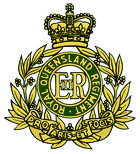
31/42 RQR Flag:
Infantry ‘Unit’ Flags reflect the Unit Lanyard Colours and have the Units Regimental Crest/Badge fitted centrally on the flag, with Roman Numerals displayed in the top Left Canton of the Flag indicating the units designation number. The use of Roman Numerals indicates a Combat Unit, while Arabic Numerals are used it indicates a non combat or supporting Unit.
Unit Shoulder Patch (USP):
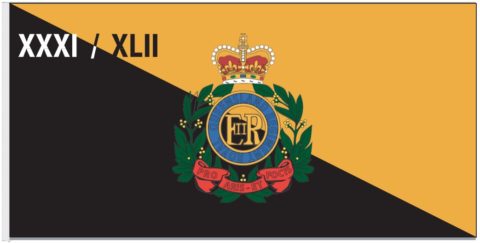
Unit shoulder patch. Unit Shoulder Patch (USP) differs from identification arm patches. Only an authorised USP may be worn. The USP is worn in barracks, with General Duty Dress (DPCU) on the velcro patch on the right sleeve of the DPCU shirt. The USP is not to be worn on operations or field exercises. Only one patch is to be worn on the right sleeve of the DPCU shirt. USP are not to be sewn onto the sleeves of DPCU shirts.
Colour Code legend
Red represents the 2nd Division.
Sky Blue with Arabic Numeral 11 – represents 11 Brigade.
Unit Colour Patch with Arabic Numerals’ and Alphabetical designator represents 31/42 RQR.
Unit Shoulder Patch (USP):
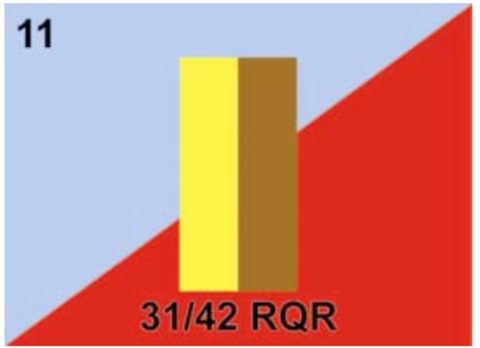
Field shoulder patch. Only an authorised Field Shoulder Patch (FSP) may be worn on the velcro patch on the right sleeve of the DPCU and AMP shirt. The FSP is worn only with Field Dress (DPCU) and AMP uniform, when participating in field related training activities or during field exercises. The FSP may be worn in the field during exercises overseas, but not on operations. The FSP may be worn in barracks, but only when Field Dress (DPCU) or AMP uniform are worn for field related training activities. The FSP is not to be worn in the barracks environment when General Duty Dress (DPCU) or AMP uniform are worn and it does not to replace the USP when this order of dress is worn. The FSP is not to be sewn onto the sleeves of the DPCU and AMP shirt.
3.149The FSP design is to be approved by the commander or unit CO and oversight for the design is to be the Bde or Formation RSM. The command oversight is to be AHQ; however, functional commands, ie HQ FORCOMD, HQ SOCOMD and HQ 1 Div are responsible to manage their respective FSP registers.
3.150The FSP design may be a subdued version of the USP or an independent low visibility design that meets the Army’s values.
3.151The design, provision and maintenance of the FSP are at the units expense, by using only non-public monies, eg Regimental Trust Funds. Commonwealth monies are not to be used in any circumstance.
3.152The wearing of the FSP is not mandatory, but units that authorise a FSP are to apply consistency within its sub-units. Sub-units FSP within a unit are not authorised to be designed or worn.
History of the 31/42 Unit ‘Field’ Patch Development
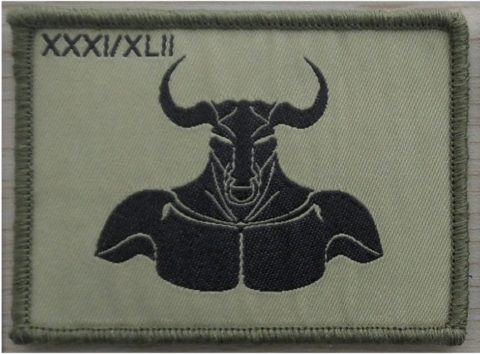
In 2016, as part of the Unit recruiting strategy, the 11 BDE PA Officer CAPT Trainer, recommended to CO 31-42 RQR, LTCOL Keith Potter, that 31/42 RQR needed to develop a ‘brand image’ to use as a tool to help market the Unit to the Army and to the general public (recruiting).
LTCOL Potter subsequently tasked Battalion Unit Recruiting Liaison Officer (URLO) WO2 Matthew Connell, and the Adjutant CAPT Ryan Muller, to commence the development of a suitable ‘brand’ with the following guidance
WO2 Connell and CAPT Muller raised several ‘draft designs’ for consultancy amongst the men of the Battalion. At the end of the consultancy, the men chose the ‘Minotaur Logo’ for the following reasons;
LTCOL Potter subsequently approved the Minotaur brand logo and tasked the RSM, WO1 Maitland to confirm that the design met with Army standards, including the material colours.
When the design and colours were confirmed, the Battalion Executive Officer, MAJ Ian Reid, was tasked to commission 300 field patches.
MAJ Reid engaged the services of A1 Embroidery Services, an Army approved Unit Shoulder Patch provider to commission the Field Patch.
In September 2016, 300 patches were received by the XO for use by the Battalions Soldiers..
THE NINETEENTH anniversary of Reserve Forces Day was commemorated in Brisbane on Saturday, July 1, with a Recognition Ceremony and Wreath Laying in Anzac Square.
The first ceremony to recognise the contribution made to the defence of the Australian nation by the Militia — a military force that is raised from within the civilian population to supplement a regular army in conflict or an emergency — was instigated in 1998 by a committee under the chairmanship of LtCol George Hulse.
This year, more than 100 former and serving members of the three services of the Australian Defence Force, international visitors including a French Reserve Unit from New Caledonia under the Command of Docteur Christian Airault, President de l’ANM ONM-NC, plus Cadets from the three services, and civilians commemorated the day organised by the Reserve Forces Day Committee headed by Captain R W G Hume (R).
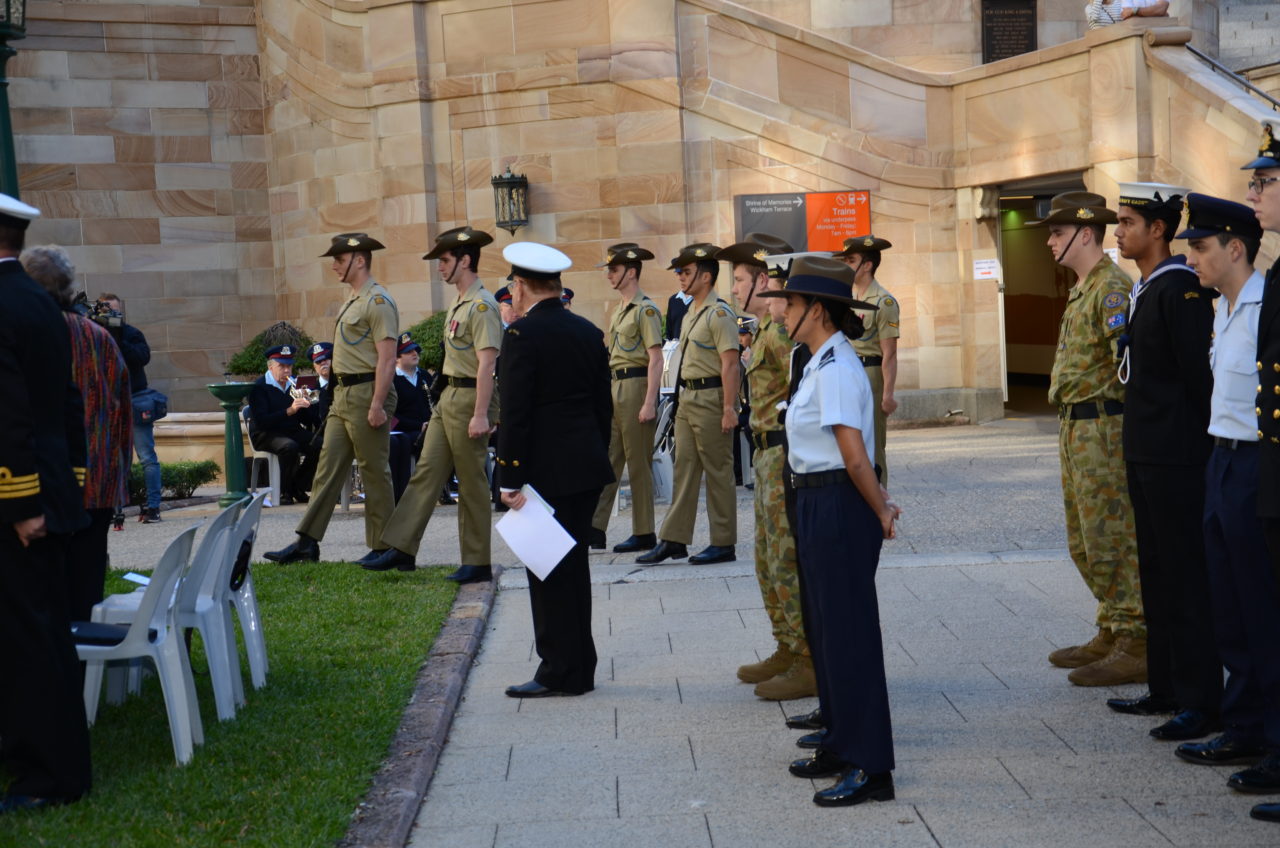 Parade Commander was Squadron Leader Dennis Deering KSJ (R).
Parade Commander was Squadron Leader Dennis Deering KSJ (R).
Cadets from the Naval Training Ship, Vengeance ANC, 12 Army Cadet Unit AAC and 219 (City of Brisbane) Squadron also participated in the ceremony.
The Catafalque Party was drawn from the Royal Australian Naval Reserve, the Army Reserve and the Royal Australian Air Force Reserve.
The Lawrie Young Concert Band of Brisbane provided the music.
Principal Guest was Commander Robert Horsnell CSC RANR, representing the Chief of Navy, who remains an active member of the Reserve, is semi-retired and he and his wife list themselves as Grey Nomads.
In his address to the Parade, Commander Horsnell initially recognised the efforts of LtCol Hulse, noting that “19 years on, this day is still alive and well.”
He said that as he and his wife travel Australia, they stop in country towns and villages and pay their respects at local War Memorials. “It saddens me to see the number of personnel whose names are inscribed on those memorials,” he said. “It seems that there is no corner of this country that has not been affected by the horror of war.
“In particular, my heart goes out to those communities where I see a surname repeated two or three times. I can’t even begin to comprehend the enormity of the grief those families and communities must have suffered,” he noted.
“I dare say some of the families may never have recovered.
“While we will always remember the fallen, we must also keep in our hearts their families. Lest We Forget.”
He continued: “Today we recognise the contribution made by our Reserve Force personnel — both past and present — and it is a long and distinguished contribution made by over one-and-a-quarter million Australians.”
Commander Horsnell asked those to remember that Reservists, in their many guises, served long before the nation had regular permanent forces.
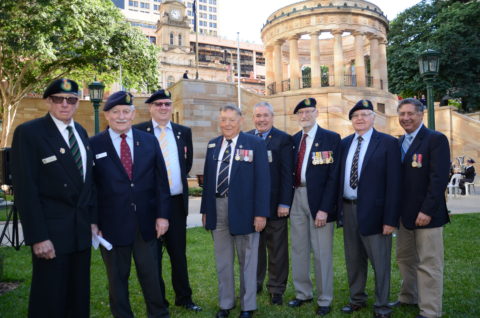
Members of the Brisbane branch of the 31st Infantry Battalion Association at the Reserves Forces Day Recognition Ceremony: Ray Fogg, Tony Wadeson, Mick James, Rod Golding, Alex Garland (president of National Servicemen’s Association of Queensland), Doug Moffett, Eugene Farrell and LtCol Mick Byrne.
“Their service goes as far back as 1794 when 1,500 volunteers were raised to maintain order on Norfolk Island; from 1863 to 1864 when 2,500 personnel were sent to New Zealand to participate in the Waikato War; through the Boer War and to the catastrophes of the twentieth century.
“The long-awaited peace dividend failed to materialise at the end of the Cold War, and the world was plunged into another period of uncertainty leading to the ongoing war on terror.
“Our Reserves were and are still there,” he said.
“Not only are they there for high-end warfare, but their contribution covers the entire spectrum of conflict, from humanitarian aid and disaster relief to constabulary operations, border security — the list goes on.
“They are an integral and essential part of the Australian Defence Force — and never more so than today.
“Our Reservists have been there on every occasion, are still there either in front line combat units or direct support to operations, and they will continue to be there — simply because, that is what they choose to do.
“They stand-up when called, and get the job done,” Commander Horsnell emphasised.
“And in recognition of that service and commitment, I extend my thanks on behalf of the Australian nation to those of you who have served in the Australian Defence Reserves, and those currently serving.”
He continued: “Of course, for our Reservists to be able to focus on their mission, they must be supported by their immediate and extended families, and their employers. In recognising the service of our Reserve Forces, we must also recognise the support and sacrifice of those in the background.
“Put simply, without your support, without the flexibility, commitment and understanding, I doubt if our Reserve Forces would be as capable and proficient as they are today.”
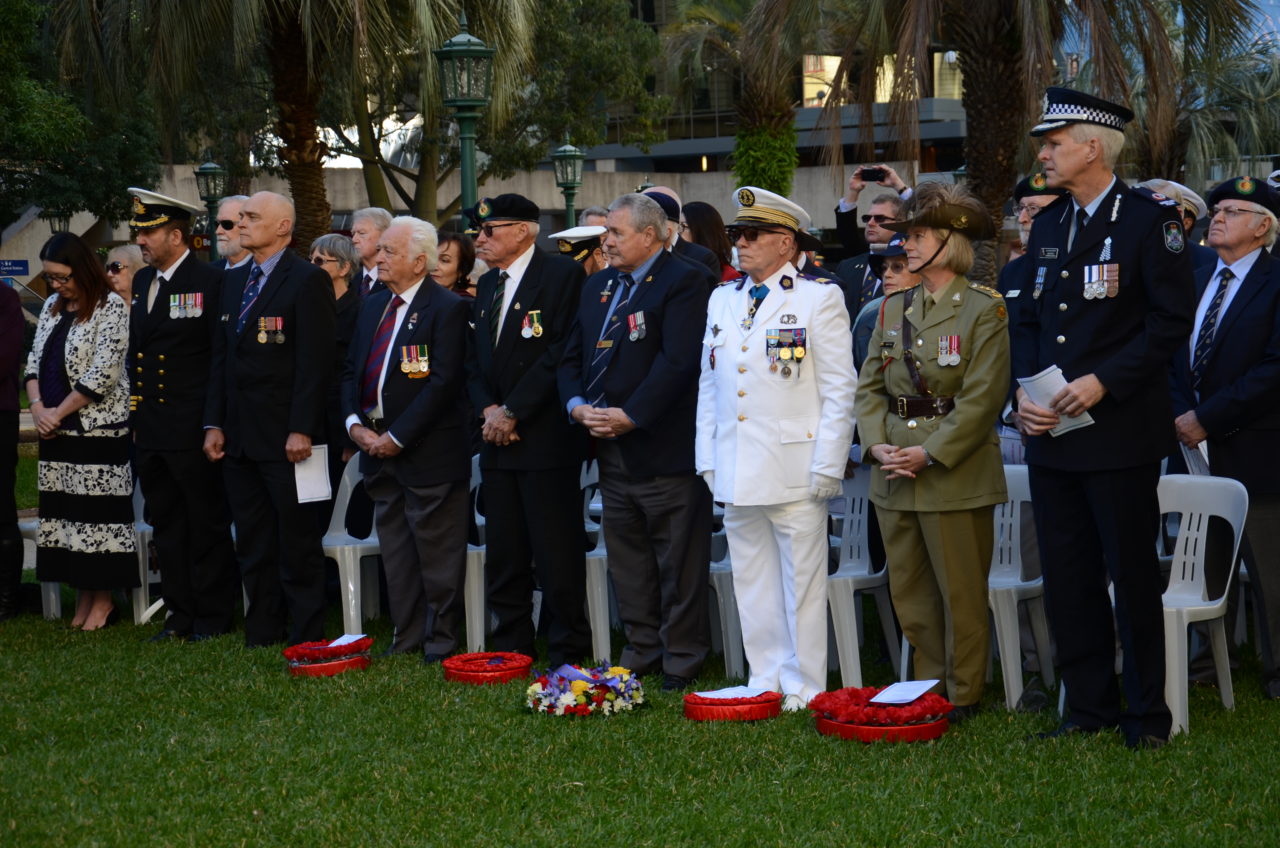 Commander Horsnell then turned to the future, noting in particular the Cadets in attendance.
Commander Horsnell then turned to the future, noting in particular the Cadets in attendance.
“To you junior member of the Reserve, I’d like to say that by becoming a Reservist, you have taken a huge step into a bigger world — a world of service, of sacrifice, and of discipline.
“You have joined something much bigger than yourself — an institution that is, I would argue, the greatest and most respected in Australia — the Australian Defence Force.
“It has never been a better time to have taken that step,” he advised.
“Why? There are opportunities to serve locally and abroad in a huge variety of trades and profession — with more being added as technology and threats change.”
He highlighted cyber defence as being a topical and perfect example.
“There are any number of ways your service can be structured to align with your civilian employment commitments. The training will be at no cost.
“You are more closely aligned and integrated with permanent forces than ever before — providing opportunities for sharing of knowledge, skills and experiences. Support for you, your family and employer will be there. The list goes on.
“All you have to do is decide what you want to do — just do it,” Commander Horsnell advised.
“I urge you to look at our Reserve Force’s history. Look at it and learn from the extraordinary leaders that have come from it — General Monash of Gallipoli and France fame in World War I, LtCol Honner of the 39th Battalion on the Kokoda Track, as just two of many examples.
“You are now part of an extraordinary group of people with a long, proud and distinguished history of service.
“Follow their lead and step up. I congratulate you on your decision.
“Now it’s up to you!”
The ceremony continued with a wreath-laying, Cadets were called-on to recite The Ode, and was followed by the National Anthems of France and Australia.
During the service, Cadets also read messages from the Governor-General, Sir Peter Cosgrove, and Prime Minster, the Hon Malcolm Turnbull (see below).
AS A PRELUDE to Reserve Forces Day in Brisbane, a Cocktails Evening was held on Friday, June 30, in the Combined Officers’ and Sergeants’ Mess at Victoria Barracks, featuring Military-Style entertainment.
The event concluded with a lowering of the Flag accompanied by a Naval Hymn in an harmonised adaption of the Sunset ceremony.
Officer-in-Charge was Chief Petty Officer Ken Browning, and Naval personnel officiating at the Flag Lowering were Petty Officer Joe Lee (facing camera) and Petty Officer Lloyd Dannanberg
Ceremonial Commander was Colonel George Kearney (R), Immediate Past Colonel Commandant of the Australian Army Psychology Corps.
The cocktail reception has become a popular prelude to Reserve Forces Day in Brisbane, with previous events having been held at the Brisbane Maritime Museum and RAAF Amberley.
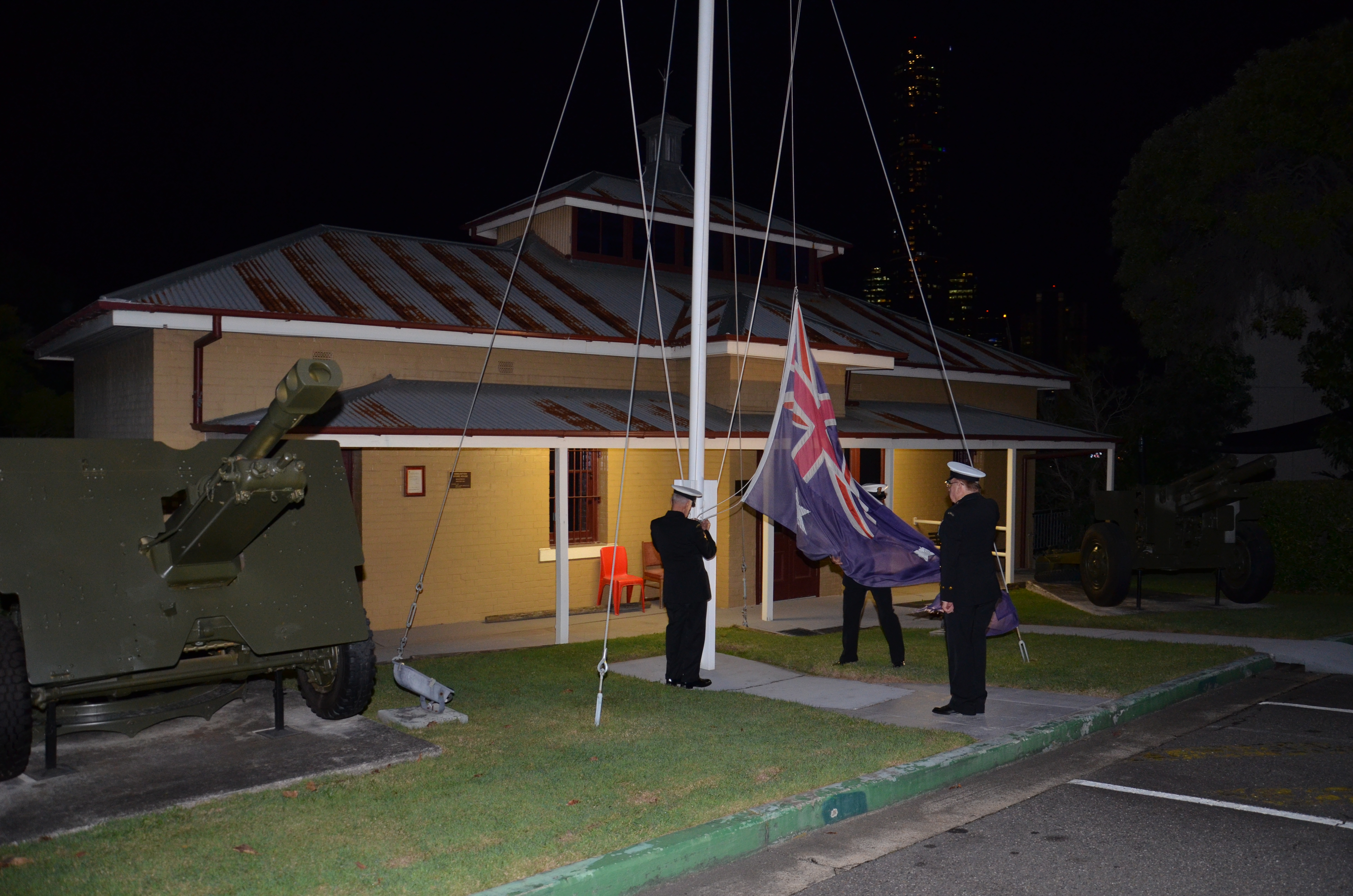
THE ROLE of the Reserve Forces within the Australian Military will be commemorated on Saturday, July 1, 2017.
In Brisbane on Friday night (June 30) the traditional Cocktail Party will be held in the Combined Officers’ and Sergeants’ Mess at Victoria Barracks, Petrie Terrace, Brisbane.
Previous events have been held at the Brisbane Maritime Museum and RAAF Amberley.
This years Cocktail Party will feature traditional Military style entertainment, commencing at 1800 hours through till 2000 hours.
Generous finger food will be served during the evening, and each ticket holder will receive three free bar drinks. A cash bar will also be operating for when the ticket limit expires.
Dress for Military personnel is Service Dress with medals; for civilians it is Lounge Suit/After Five wear with medals.
Tickets are still available for this All Ranks event: contact Tony Wadeson (Secretary, Brisbane branch, 31st Infantry Battalion Association) by emailing wadesonriver@aapt.net.au.
A bus will be travelling to Victoria Barracks from Kedron-Wavell RSL. Details can be obtained from Tony Wadeson.
The following morning (Saturday) a Memorial Ceremony will begin in Anzac Square, Brisbane, at 1000 hours. We require a good turn-out of members to maintain the Association’s reputation for having the highest numbers on parade. Afterwards we plan to adjourn over the road to our usual haunt to discuss the event.
Following are letters from Governor-General Sir Peter Cosgrove and Prime Minister Malcolm Turnbull.
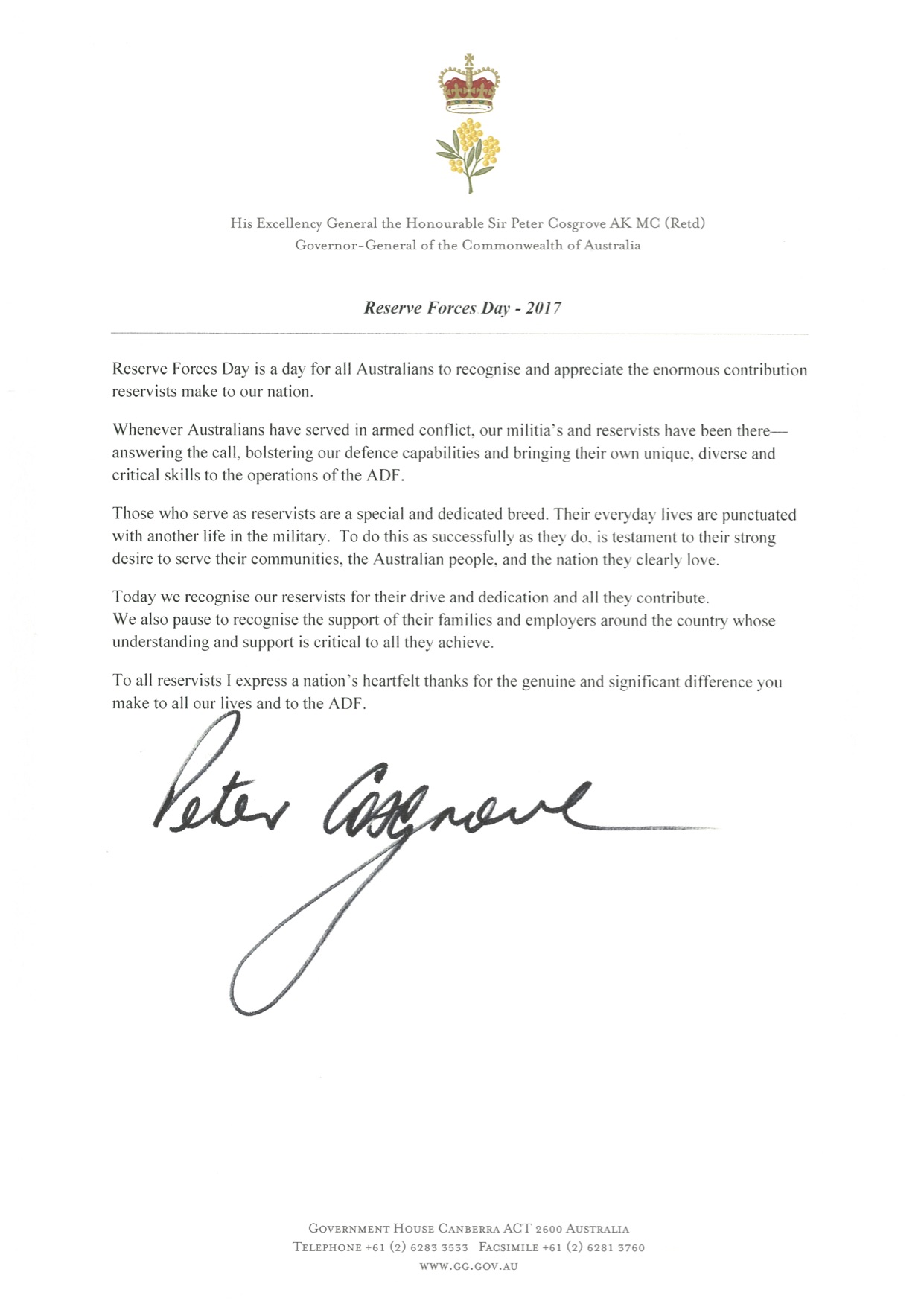

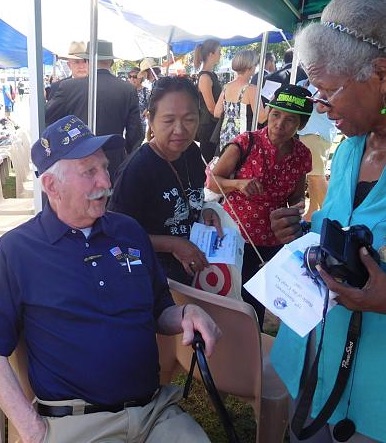
Photo courtesy Felix Reitano, Ingham.
A MOVING Commemorative Service on the 75th Anniversary of the Battle of the Coral Sea was held in Cardwell on Sunday, April 30, 2017, with a large crowd in attendance at Coral Sea Park.
Hinchinbrook MP, Andrew Cripps, said he was delighted to see a large crowd of locals and visitors gather in Cardwell to show their respect and mark the important 75th Anniversary of the Battle of the Coral Sea.
“It has an honour to have senior US diplomats James Carouso and Valerie Fowler in attendance, along with 93-year-old USS Lexington and Coral Sea battle veteran, Cecil Wiswell (pictured)” he said.
“A special mention must be made of Anne Mealing and Noeline Byrne, who have both made such a significant and long term commitment to this annual memorial service in Cardwell”.
Mr Cripps expressed his gratitude to all those who turned out to march in the parade, and those volunteers who helped to set-up shelter and provide catering for the community to enjoy the day in Coral Sea Park.
A special event was held at the Cardwell Community Hall on Saturday night before the 2017 Battle of the Coral Sea service in recognition of the historic 75thanniversary.
THE FOUNDATIONS of Anzac Day were revealed on the Anzac Centenary Queensland Facebook site, especially to members of the 31st Battalion and its predecessors.
Apparently, Canon David John Garland is referred to as the ‘architect’ of the Anzac Day activities, originally being tasked in this role by a committee formed in Brisbane in January 1916 to look at commemorating war casualties.
What is not generally known is that Canon Garland was a member of the Kennedy Regiment (the forerunner of the 31st Battalion) in 1905. In a previous edition of “Crossed Boomerangs,” produced by Bob Burla, a photo appeared of the Officers in 1905 that includes Canon Garland (middle row, on right), who was stationed in Townsville for a few years after transferring from Perth.
Two other former officers of the 31st Battalion on the committee were Lt Eustace Murphy (back row, second from left) and Captain and Brevet Major Frederick William Toll (middle row, left).
This information adds to the extensive and proud history of the 31st Battalion that has been accumulated over more than a century.
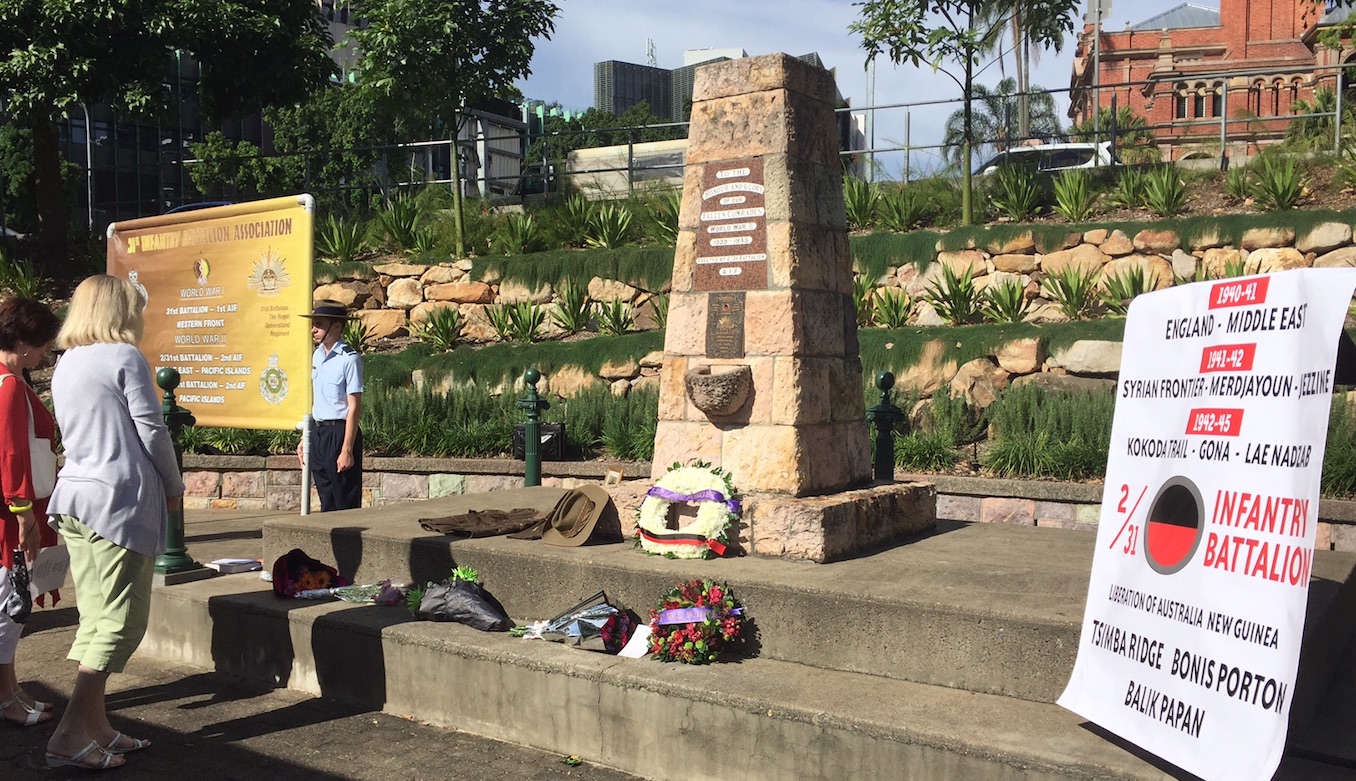
A ceremony was held at the Memorial of the 2/31st at South Bank before Brisbane’s Anzac March.

A fine body of men assembled for the Brisbane march.
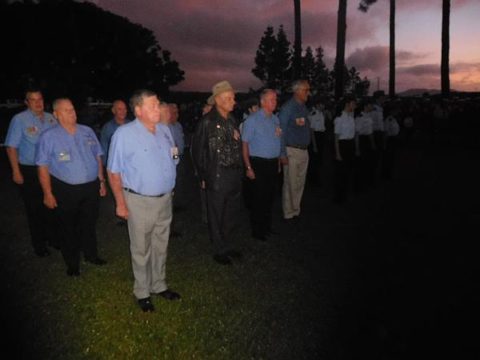
Ingham branch president, Felix Reitano, has noted that the local Dawn Service was the biggest he has ever seen.”

Ingham branch member, 98-year-old Vic Huddy, is assisted from his transport by the Commander of 8 Platoon, C Company, 1 RAR.
WHEN the French Foreign Legion flagged its place in military history at the Battle of Cameron on April 30, 1863, it created a permanent narrative that is read annually before the troops of the elite French unit on the date that marks the battle’s anniversary — and Legion Day.
The ‘Story Of Cameron’ is an epic version of a battle between the Foreign Legion and the liberal troops of the Mexican Government, during the French expedition into Mexico. It has become legend in French military history.
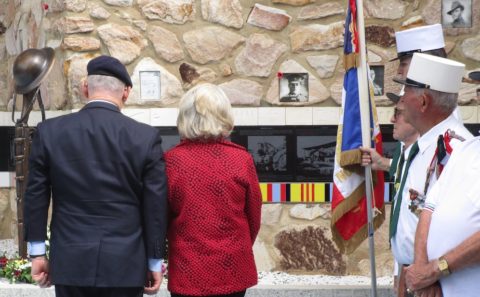
Secretary of the Brisbane Branch of the 31st Infantry Battalion Association, Tony Wadeson, and his wife Ronda, lay a wreath at the cenotaph. Ronda’s uncle and Tony’s relation were both killed in the first Battle of Bullecort on April 11, 1917.
On Sunday, April 30, 2017, amidst a mix of uniforms, headwear and accoutrements from fields of warfare past relative to the nations of Australia and France, a Commemoration was held at the Geebung Zillmere Bald Hills Aspley sub-branch to honour not only the 154th anniversary of Cameron Day, but the first and second Battles of Bullecort on the Western Front in World War I.
Guests of Honour were State President of the RSL Queensland, Stewart Cameron, and President of the French Foreign Legion Association, Jose Calvo; host was the President of the GZBHA RSL Branch, Gary Lancaster.
Camerone Day is the most important event of the Legion Etranger, as it best represents the fighting spirit of these men. The wooden prosthetic hand of Captain Danjou is brought-out for display and veneration in special ceremonies at the Legion headquarters at Aubagne, France. On that day, Officers prepare the coffee for their men to celebrate the one they didn’t have time to drink before the battle.
Captain Jean Danjou is a renowned leader in the annals of French military history. He was born in Chalabre, enrolled in the Ecole Speciale Militaire de Saint-Cyr — the foremost French military academy — and graduated from the Academy at the age of 20.
The story began when the French Army beseiged Puebla. The mission of the Legion was to ensure the circulation and safety of the convoys for 120kms.
The Commander, Colonel Jeanningros, learned on April 29, 1863, that a large convoy carrying three million in cash, siege equipment and ammunition was on its way to Puebla.
Captain Danjou, his adjutant-majorm decided to send a company to meet the convoy. The third company of the Foreign Regiment was designated — but there were no officers available. Captain Danjou himself took command; sub-lieutenants Maudet (standard bearer) and Vilian (payor) joined him voluntarily.
On April 30, at 0100hrs, the company with a strength of three officers and 62 men, set out. They had travelled about 20kms when, at 7am, they stopped at Palo Verde to make coffee. At that moment, the Mexican force of 2,000 (800 cavalry and 1,200 infantry) appeared, and fighting began immediately. Captain Danjou ordered that a square be formed and, while withdrawing, successfully repulsed several cavalry charges — and inflicting severe losses on the enemy.
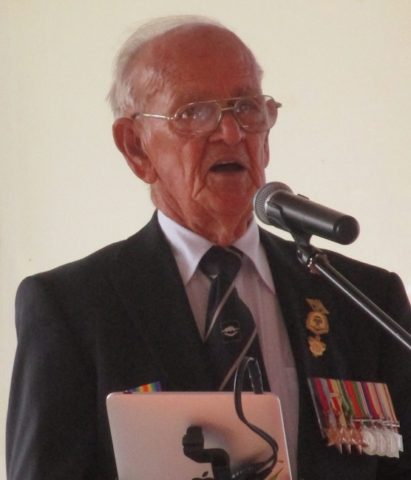
A 94-year-old Rat of Tobruk addressed the Commemoration lunch.
They retreated to the nearby Hacienda Cameron, an inn protected by a three metre high wall.
Captain Danjou’s plan was to create a diversion for the enemy forces to prevent attacks on the approaching convoy.
While the men were hastily organised the defence of the inn, a Mexican officer — asserting his great superiority — summoned Captain Danjou to surrender.
He replied: “We have cartridges, and we will not surrender.”
Then, raising his hand, Captain Danjou swore to defend to the death — and caused his men to take the same oath. It was then 10am.
Until 6pm, the 60 men who had not eaten or drank since the day before, and despite the extreme heat, hunger and thirst, resisted the 2,000 Mexicans.
At noon, Captain Danjou was killed with a bullet to the chest. At 2pm, Second-Lieutenant Vilain was felled by a bullet to the front. At the same time, the Mexican colonel succeeded in setting fire to the inn.
Despite the heat and smoke that increased their suffering, the Legionnaires stood their ground, though many were wounded. By 5pm, with Second-Lieutenant Maudet in command of only 12 men still able to fight, the Mexican colonel assembled his men and told them of the shame they would bear if they could not bring-down that handful of brave men.
(The words were recorded by a Legionnaire who understood the Spanish language).
The Mexican strategy was to make a general assault on the breaches that they had succeeded in opening — but not before Colonel Milan send another call for Lieutenant Maudet to surrender. This offer was repulsed with due contempt.
The final assault began. Soon, there were only five men with Maudet — Corporal Maine, Legionnaires Catteau, Wensel, Constantine and Leonhard — and each had one cartridge left.
They stand with fixed bayonets, in a corner of the courtyard, they back against a wall, and they face their enemy.
On command, they each discharged their last round at point-blank range and bayonet-charged the enemy. Lieutenant Maudet and two Legionnaires were beaten to death. Maine and his two comrades were about to be massacred — when a Mexican officer intervened and saved them.
“Rendez-vous!” he shouted. “We will surrender if you promise to raise and care for our wounded — and if you leave us weapons.” They stood alone — their bayonets trained on the enemy.
The Mexican officer replied: “Nothing is denied to men like you!”
Declaring his admiration for their courage, the Mexican officer spared the surviving men and allowed them to form an honour guard for the body of Captain Danjou. They were later released and repatriated to France. Captain Jean Danjou was buried in Cameron on May 3, 1863.
Captain Danjou’s men maintained their oath to the end. For 11 hours they resisted 2,000 enemy — killing 300 and wounding just as many. Through their sacrifice, they fulfilled the mission entrusted upon them — saving the convoy.
The Emperor Napoleon III decided that the name ‘Cameron’ should be inscribed on the flag of the Foreign Regiment, and that the names of Danjou, Vilain and Maudet be engraved in gold letters on the walls of ‘The Invalides’ in Paris
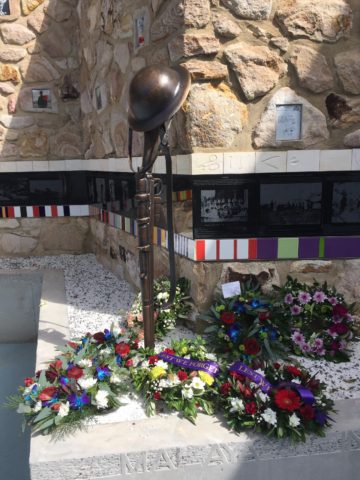 Additionally, a monument was erected in 1892 on the site of the battle. It carried the inscription (written in Latin):
Additionally, a monument was erected in 1892 on the site of the battle. It carried the inscription (written in Latin):
They were here less than sixty
Opposed to an entiry army,
His mass crushed them.
Life rather than courage
Abandoned these French soldiers — April 30, 1863.
To their memory, the country raised this monument.”
Since then, when Mexican troops passed in front of the monument, they presented arms.
The original monument has since been abandoned, and another built. It was officially inaugurated in 1963 on the centenary of the Battle of Cameron, and carries the inscription written in French:
They were here less than sixty
Opposed to an entire army.
His mass crushed them.
Life rather than courage
Abandoned these French soldiers.

Following the ceremony, a lunch was held within the GZBHA RSL Club, where the food and entertainment was decidedly French.
During the speeches, mention was made of the 42nd Battalion and its feats on the Western Front, where is earned the nomenclature of “the Australian Black Watch.”
In recently times, the 31st Battalion has been combined to form the 31/42 Battalion of the Royal Queensland Regiment.
Seven members plus three wives of the 31st Infantry Battalion Association attended the commemoration service and lunch.
Pictured below are some interesting aspects of French life that confronted our members.
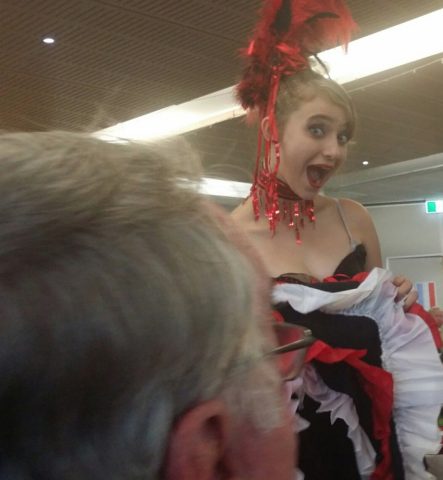
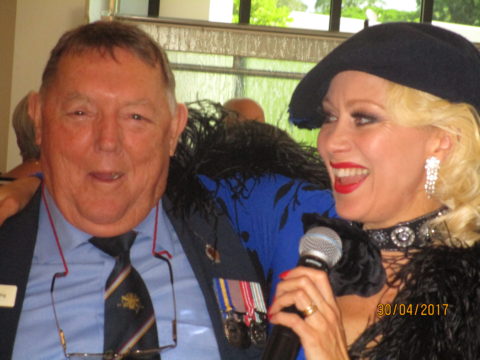
GOLD COAST: Currumbin RSL Cenotaph: Sunday, June 25 — 1000 hours
BRISBANE: Anzac Square: Saturday, July 1 — 1000 hours
IPSWICH: The Railway Workshops Museum, North Street, North Ipswich: Sunday, July 2 — 1000 hours
GRAND CENTRAL HOTEL (under Central Station on Ann Street): March 14 — 1130 hours
BRISBANE:
TOWNSVILLE:
INGHAM:
CHARTERS TOWERS: